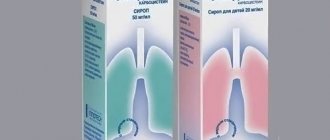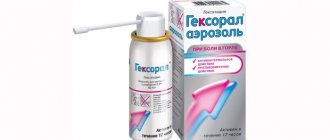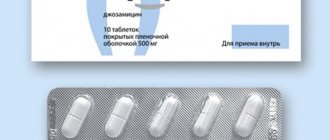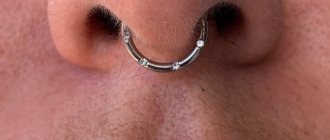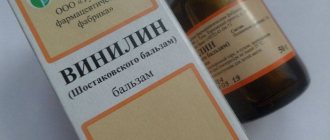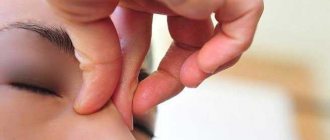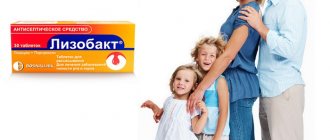Pharmacological properties
The drug is used for the symptomatic treatment of inflammatory processes in the paranasal sinuses. The active component of Cinnabaris suppresses pain, suppresses lacrimation, and eliminates the symptoms of facial neuralgia. Hydrastis and Kalium bichromicum are especially active in the acute and subacute periods during chronic or prolonged sinusitis. All three of the above-mentioned active components of Cinnabsin help relieve swelling of the mucous membrane, which subsequently leads to the complete restoration of nasal breathing.
Contraindications
An individual reaction to some components is practically the only manifestation of a side effect. However, this does not exclude contraindications to the use of homeopathy in the following situations:
- With uncontrolled and long-term use (more than 3 weeks), the risk of toxic effects on the body increases. The presence of mercuric chloride, snake venom, and lead in preparations leads to poisoning due to violation of dosage or use of homeopathy without a doctor’s prescription.
- If you have a history of allergies or special sensitivity to certain components of the drug. Self-medication can lead to incompatibility of substances contained in homeopathic preparations and drug therapy.
- Exceeding the dosage is strictly contraindicated, as this may cause a worsening of the condition.
The occurrence of even minor negative manifestations should be a signal to visit a doctor. The specialist will adjust the dosage, frequency of administration and duration of the treatment course. If the condition does not change, the drug is discontinued and replaced with a similar one.
The absence of side effects and contraindications makes it possible to treat a runny nose with homeopathic remedies in patients of any age group - from infants to the elderly. The main condition is the mandatory agreement of the treatment regimen with a qualified specialist.
Cinnabsin tablets: instructions for use
For acute diseases, children (3-6 years old) should be prescribed 1 tablet every 2 hours (however, no more than 6 times a day) until a noticeable improvement occurs, then half a tablet three times a day until recovery.
Children (6-12 years old) should take 1 tablet every hour (no more than 8 times a day), after improvement - 1 tablet twice a day. Take until recovery.
Children (over 12 years old) and adults take 1 tablet per hour (maximum 12 tablets per day), then 1-2 tablets three times a day. Continue the course of treatment until recovery occurs.
How to take for chronic diseases:
- children 3-6 years old take half a tablet three times a day;
- children 6-12 years old take one tablet twice a day;
- persons over 12 years of age should take one tablet three times a day until improvement occurs.
For chronic diseases, to prevent relapses, the course of treatment is usually 2 months.
Instructions for Cinnabsin: take half an hour before or after meals, dissolve slowly in the mouth. For children aged 3-5 years, it is advisable to dissolve the tablet in a small amount of water or give it under the tongue in crushed form.
If there is no improvement within three days, you should stop taking the medicine and consult your doctor. Should not be taken for more than 8 weeks without first consulting your doctor.
How to use Sinupret for sinusitis?
The drug provides gentle removal of mucus accumulations, making breathing through the nose easier. The composition includes only natural ingredients that guarantee rapid action and do not have serious adverse reactions.
Sinupret is allowed to be combined with other medications. It has immunomodulatory qualities and is affordable.
For therapeutic purposes with progressive sinusitis, the following dosages are established:
- In tablet form or in the form of dragees, the drug is prescribed for adults and children over 12 years old, 2 tablets 3 times every day. Children 6-12 years old are prescribed 1 tablet three times a day. The course of therapy lasts 7-14 days. The dosage must not be violated. In this form, Sinupret is not prescribed to children under 6 years of age.
- The drops are alcohol based. They are first scooped into a tablespoon or small container of water. Adults take 50 drops. Knock 3 times. The duration of treatment is no more than 2 weeks. Children 2-6 years old are prescribed 15 drops, and 6-18 years old - 25 drops.
- Syrup is a form that is most convenient for treating children. Dosage is done using a measuring cap. Children aged 2-5 years are prescribed 2.1 ml, and over 5 years old - 3.5 ml three times a day. There is no need to dilute the syrup, but it can be washed down with a small amount of liquid. The product is shaken beforehand. Sinupret is given to the child after or during meals.
During pregnancy and lactation, the drug can be prescribed after assessing the benefits for the mother and the possible danger to the baby. If the doctor’s conclusion is positive, tablets or pills are chosen for treatment of sinusitis.
Sinupret or Cinnabsin?
Sinupret is recommended to be taken when a viscous secretion forms. It is contraindicated during pregnancy, lactation, and children under 6 years of age. Thanks to its natural composition (verbena, sorrel, primrose, elderberry, gentian), it quickly and effectively relieves swelling and reduces the viscosity of mucus. Duration of use is approximately 7-10 days.
Cinnabsin, for which it is often chosen, helps with more acute diseases; it can be used for children over 3 years old and for pregnant women. It can also be used for prevention, in addition, it has properties of strengthening the immune system.
Cinnabsin and Sinupret, which to choose?
Cinnabsin and Sinupret are used in the treatment of sinusitis of varying severity, so it seems that the drugs are similar and one can fully replace the other. Your doctor should decide what is best for you. There are differences in the action of drugs that seem insignificant at first glance, but in your particular case may be decisive:
- Cinnabsin has a broader mode of action. In addition to the anti-inflammatory effect, like Sinupret, it has an immunostimulating effect.
- Cinnabsin is available only in tablet form. Sinupret has dosage forms in the form of drops, syrup and dragees, which is much more convenient when treating children.
- Cinnabsin is used in the treatment of sinusitis in children over 3 years of age and is suitable for courses of treatment lasting 2 months or more. Sinupret, despite its exclusively herbal composition, is recommended for children over 6 years of age, with a treatment duration of up to 2 weeks.
- When choosing Cinnabsin or Sinupret, you should pay attention to contraindications, which will immediately help you make a choice in favor of one of the drugs. For example, Sinupret is not used for diseases of the liver, kidneys and gastrointestinal tract.
- The choice of medication may be influenced by the lower price of Cinnabsin compared to Sinupret.
There are many parameters, but the choice should be justified by the feasibility of using the medicine in a particular case. Only a specialist should give a recommendation on what is best to use for such a serious disease as sinusitis.
The inclusion of Cinnabsin in the treatment regimen for sinusitis not only allows you to get rid of painful symptoms, but also stimulate the immune system, reduce the likelihood of relapses and the transition of an acute disease to a chronic form.
The reliability and safety of the drug is confirmed by the guarantees of the German manufacturer Deutsche Homoopathie-Union DHU-Arzneiraittel GmbH&Co. KG. Long-term use of a homeopathic drug demonstrates its effectiveness in diseases of the nasal mucous membranes, such as sinusitis, sinusitis, sinusitis, frontal sinusitis, and hypertrophy of the nasopharyngeal tonsils.
source
Reviews
Patients who took Cinnabsin tablets gave generally positive reviews:
The moment of truth came when in winter, at minus 38, I was walking and talking with my friend. We are such talkative women - we don’t even care about the frost. It all ended with a decent cold burn to my larynx, which turned into laryngitis. Evil bacteria took advantage of this and immediately provoked an exacerbation of purulent sinusitis. This time I immediately started taking Cinnabsin. That’s when I became convinced of its high effectiveness! I dealt with sinusitis in a week without antibiotics - an absolute record!
My husband decided to try Cinnabsin when his sinusitis once again worsened. I started taking 1 tablet 3 times a day. On the 2nd day, his sinus discharge increased. Liquid mucus came out. That is, the drug began to liquefy the contents of the maxillary sinuses and, accordingly, the sinuses began to clear.
Immediately, as soon as signs of sinusitis begin: headache, nasal congestion, a feeling of fullness of the maxillary sinuses or copious discharge from the nose, I immediately begin to dissolve Cinnabsin, 1 tablet every hour or two, 7-8 tablets come out (but no more than 12 tablets per day ) for about 4 days, and then 1 tablet 3 times a day until complete recovery. And also, at the same time, rinse your nose 2 times a day with saline or some kind of antiseptic solution (furacillin). I drip pinosol into my nose. This treatment regimen was prescribed to me by a doctor; we do without punctures or antibiotics. And since cinnabsin is of natural origin, it can also be used by children over 3 years old, without harm to health.
Are there analogues of Cinnabsin?
This medication has no analogues that are identical in composition. However, there are many other drugs that have similar effects. Among them are Nasonex, No-Sol, Dolphin, Euphorbium compositum, Asinis, Snoop, Rinostop, Adrianol and others.
Cinnabsin tablets are a popular remedy for sinusitis (sinusitis, sinusitis, ethmoiditis) and adenoids. Safe and effective, it will help get rid of unpleasant symptoms, strengthen the immune system and reduce the likelihood of relapses.
There are other drug treatment options for runny nose and sinusitis. Homeopathic tablets Corizalia for children in the treatment of sinusitis are very effective. One of the advantages of Coryzalia is that it can be taken with other tablets.
CINABSIN: instructions, reviews, analogues, price in pharmacies
Homeopathic medicine Tsinabsin
has anti-inflammatory and immunostimulating effects. Reduces swelling of the mucous membranes of the nasal cavity and paranasal sinuses, facilitating nasal breathing.
Pharmacological properties
The pharmacological properties of the drug Cinnabsin are based on its main components - 4 medicinal substances, which in general effectively affect most of the symptoms observed in various sinusitis, for example, inflammation of the maxillary and frontal sinuses.
The use of the drug allows you to quickly and effectively relieve symptoms typical of inflammation of the paranasal sinuses, such as dull headaches, a feeling of heaviness in the head, lacrimation or trigeminal neuralgia. At the same time, the Cinnabaris ingredient helps primarily at the initial stage of the disease.
The components Hydrastis and Kalium bichromicum are effective mainly in acute and chronic forms of the disease, which is often observed in long-term sinusitis. All three of these ingredients help relieve swelling of the mucous membranes and thereby facilitate nasal breathing. In addition, they reduce the secretion of mucus and secretions, as well as relieve the feeling of pressure in the entire head.
The fourth ingredient - Echinacea - provides a general strengthening of the body's defenses. It promotes recovery from infectious diseases accompanied by fever and generally reduces the frequency of relapses.
Mercury compounds are characterized by an affinity display on the mucous membranes and a tendency to inflammation, which is accompanied by purulent discharge. The picture of the remedy Cinnabaris indicates the typical symptoms of sinusitis.
A runny nose appears with yellow-green, thick or copious secretions. Thread-like mucus penetrates from the choanae into the throat. The feeling of pressure on the root of the nose is similar to pressure from heavy glasses. Pain in the eyes, lacrimation.
The patient wakes up from a dull headache in the frontal region.
Hydrastis is a deeply penetrating remedy for mucous membranes with thick or stringy yellowish discharge, especially in the nasopharynx. The remedy has proven itself in the treatment of catarrh of the paranasal sinuses. The main symptom is a constant painful runny nose, thick secretions from the choanae, lacrimation and dull headaches in the frontal region.
Kalium bichromicum is effective for inflammation of the frontal sinuses and maxillary sinus. Areas affected by inflammation are characterized by abundant purulent-mucosal viscous discharge, which often leads to the development of ulcers.
Among the accompanying symptoms are unilateral periodic headaches, pressure on the root of the nose, which decreases with mucus secretion, and sleep disturbances.
Typically when using the product, increased sensitivity to cold and deterioration in well-being in the morning are considered.
Mode of application
For acute illness Tsinabsin
for children under 12 years of age, take 1 tablet every 2 hours (no more than 8 times a day) until improvement occurs. For further treatment, take 1 tablet 3 times a day.
For children over 12 years of age and adults, for acute illness, take 1 tablet every hour (no more than 12 times a day) until improvement occurs, then 1-2 tablets 3 times a day.
For chronic inflammation of the paranasal sinuses, a longer course of treatment with Cinnabsin
.
The tablets are taken half an hour before meals or half an hour after meals, slowly dissolving.
For ease of use, children under 3 years of age are recommended to dissolve the tablet in a small amount of liquid.
The harmful effects of overdose are unknown.
Pregnancy
Cinnabsin
During pregnancy and breastfeeding, it can be used only after a careful assessment by a doctor of the ratio of benefit to the mother/risk to the fetus (child).
Interaction with other drugs
The interaction is still unknown.
Overdose
In cases of overdose of the drug Tsinabsin
there may be an increase in the incidence of adverse reactions.
Release form
Tablets of 100 pieces per package.
Compound
Active ingredients: 1 tablet contains: Cinnabaris D3 - 25 mg, Hydrastis D3 - 25 mg, Kalium bichromicum D3 - 25 mg, Echinacea D1 - 25 mg.
Excipients: lactose monohydrate, magnesium stearate, wheat starch.
Additionally
Taking Cinabsin may, due to the wheat starch content, have a negative effect on patients suffering from celiac disease.
When using homeopathic medicines (in particular Cinnabsin), a temporary primary deterioration may occur. In this case, you should stop taking the drug and consult your doctor.
Source: https://www.medcentre.com.ua/medicamenty/tsinabsin.html
Side effects
When treated with Cinnabsin, some patients experience the development of various allergic reactions, such as skin rashes, urticaria and itching. In addition, in some patients, taking the drug is accompanied by the development of increased salivation. If side effects develop, it is recommended to reduce the dosage or completely stop taking the medication.
The drug is well tolerated and without severe effects on the body causing side effects. Negative reactions can only occur in cases of high sensitivity to the substances in Cinnabsin.
In rare cases, Cinnabsin can cause rashes or disturbances in the gastrointestinal tract. In this case, treatment with this drug should be stopped.
Like any other homeopathic remedy, Cinnabsin can provoke a temporary regression of inflammatory processes and nasal discharge. If the regression lasts more than three days, then Cinnabsin should be replaced with something else.
Sinupret - tablets (price)
Instructions for use of Sinupret tablets provide information on how to take the drug and how many days to take it. Usually Sinupret tablets for sinusitis help quickly. The effect occurs immediately, and the duration of treatment is from a week to 15 days.
The tablets have an antibacterial, anti-inflammatory, decongestant effect, plus they help avoid complications and new relapses. Reviews of the tablet form are often positive.
Pills are the most common form of medication for adults. Sinupret forte is a strengthened formula. The price of tablets for sinusitis Sinupret is 250-350 rubles.
Contraindications:
- intolerance to components;
- children under 6 years of age;
- Take with caution if you have urolithiasis, especially with oxalates (the drug contains sorrel, which is not recommended for use by such patients).
If you are pregnant, consult your doctor before use.
For children, there is another form of release: syrup and drops. Dragees differ from tablets; they are enteric-coated. This promotes better absorption of the content.
Want to know how to treat rosacea-like dermatitis? We will tell you in detail.
For information about Antitoxin Nano parasite repellent, click here, Anti Toxin Nano will remove warts and fungus in a matter of days. To remove papillomas, Papillock Plus balm will help, see for yourself, Papillock Plus will help you get rid of papillomas at home in one go.

